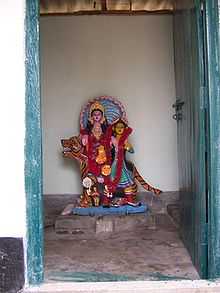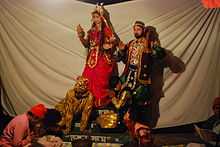Bonbibi
| Banbibi | |
|---|---|
 Banbibi and Dukhe | |
| Bengali | বনবিবি |
| Mount | Tiger or hen |
| Region | The Sundarbans (in West Bengal and Bangladesh) |
| Part of a series on the |
| Culture of Bengal |
|---|
|
|
Traditions
|
|
Mythology and folklore |
|
|
|
History
Genres Institutions
Awards
|
|
Music and performing arts |
|
Media
|
|
Sport
|
|
Banbibi (Bengali: বনবিবি, the lady of the forest), also Bandevi, Bandurga and Byaghradevi is a guardian spirit of the forests venerated by both the Hindu and the Muslim residents of the Sundarbans (spread across West Bengal state in eastern India and Bangladesh).[1] She is called upon mostly by the honey-collectors and the woodcutters before entering the forest for protection against the attacks from the tigers. It is believed that the demon king, Dakkhin Rai (the lord of the south), an arch-enemy of Banbibi actually appears in the disguise of a tiger and attacks human beings.
The narratives of Banbibi
The narratives of Banbibi are found in several texts named as the Banbibir Keramati (the magical deeds of Banbibi) or the Banbibir Jahuranama (glory to Banbibi). Amongst its earliest poets, Bayanuddin and Mohammad Khater are well known and their texts are almost similar.[2] These texts consist of two major episodes, her battle with Dakkhin Rai and the narrative of Dukhe.
In The Hungry Tide, his 2004 environmentalist novel, Amitav Ghosh mentioned two accounts of the Banbibi story of "Dukhey's Redemption."[3]

Battle with Dakkhin Rai
Banbibi is believed as the daughter of Berahim (Ibrahim), a faqir from Mecca. When his first wife Phulbibi could not bear any child, Ibrahim married Golalbibi with Phulbibi's permission tagged with a condition of fulfilling a wish of her in future. At the same time, Allah decided to send Banbibi and Shah Jangali from heaven for a divine mission. He instructed them to take birth as the children of Golalbibi. When Golalbibi became pregnant, Ibrahim left her in a forest to satisfy his first wife's wish, as he promised her earlier. Banbibi and Shah Jangali were born in the forest to Golalbibi. Allah sent four maids from heaven to take care of them. Golalbibi abandoned Banbibi in the forest left with Shah Jangali in her arms.[4] Banbibi was raised in the forest by a doe. After seven years, Ibrahim understood his mistake and took back Golalbibi and her two children to Mecca.
Once, while praying at the mosque of the prophet of Islam, Banbibi and Shah Jangali received two magical hats. With the help of those magical hats, they flew to the country of eighteen tides (atharo bhatir desh) in Hindustan (but, according to another version of the narrative, they were brought to the country of eighteen tides by Gibril). After reaching there, Shah Jangali gave the adhan (call to prayer). The country of eighteen tides (the Sundarbans) was under the control of the demon king Dakkhin Rai, till their arrival. The sound of adhan reached his ears. He sent his friend Sanatan Rai to enquire about them. When, Sanatan informed him about the duo, he decided to throw them out of his territory. While he was about to go into the battle, his mother Narayani prevented him from going and she herself went with her army of ghosts and goblins to fight them. Banbibi defeated Narayani after a long battle. But out of mercy, she returned the half of the erstwhile kingdom of Narayani and her son. Narayani became a friend of Banbibi.[2] While the inhabited part of the Sunderbans is believed as the realm of Banbibi, Dakkhin Rai is believed as the ruler of the deep forest.
Narrative of Dukhe
Once, there were two Moule (honey collector) brothers, Dhona and Mona (or Dhanai and Manai) in a village named, Barijhati. Dhona planned to go for an expedition with a fleet of seven boats to collect honey in a mahal (dense forest) of the country of the eighteen tides but his brother Mona opposed it. He took a poor shepherd boy, Dukhe along with him. Before leaving, Dukhe's mother told him to remember Banbibi in case of any serious trouble. When the fleet reached the Kendokhali char, which was a part of the kingdom of Dakkhin Rai, Dhona forgot to give an offering to Dakkhin Rai. As a result, he was not able to collect any honey of wax for three days. On the third night, Dakkhin Ray appeared in dreams of Dhona and asked for the human sacrifice. After some arguments with Dakkhin Rai, greedy Dhona agreed to sacrifice Dukhe in exchange of honey and wax. So, after collecting enough wax and honey, he left Dukhe there and returned back to village. When Dukhe was about to be killed by Dakkhin Ray in the disguise of a tiger, he started chanting prayers invoking Banbibi. On hearing his chant, Banbibi came along with her brother Shah Jangali. Shah Jangali defeated Dakkhin Rai. After defeat, Dakkhin Rai took refuge with Bara Khan Ghazi. They followed Dakkhin Rai there. Finally, Bara Khan Ghazi was able to convince Banbibi not to harm Dakkhin Rai. In return, Ghazi gave Dukhe seven cartfuls of precious items, while Rai gave him sufficient amount of wax and honey. Banbibi ordered her pet crocodile, Seko to drop him to his village. After return to the village, Dukhe popularised the worship of Banbibi in the neighbourhood. Later, Dhona married her daughter Champa with Dukhe and he became the Chaudhury (chief) of the village.[2]
Iconography
Banbibi is worshipped by her Hindu followers as Bandurga, Bandevi or even as Banbibi, and her predominantly Hindu images are found as wearing a crown and garland, carrying a club and trishul and her vahana (vehicle) is a tiger. She is venerated by her Muslim followers as Banbibi and she is known as a pirani. Her predominantly Muslim images are found with braided hair, wearing a cap with a tikli. She wears ghagra and pyjama (instead of a sari) and a pair of shoes. Both Hindu and Muslim images have a boy in her lap,[5] believed as Dukhe by her worshippers. Her vahana (mount) is a tiger or a hen.[6]
Shrines of Banbibi
In most of the shrines of Banbibi in the Sundarbans, Banbibi is worsipped along with her brother Shah Jangali and Dakkhin Rai.[1]
Notes
- ↑ 1.0 1.1 Sufia Uddin (2011). "Beyond National Borders and Religious Boundaries: Muslim and Hindu Veneration of Bonbibi". In Mathew N. Schmalz and Peter Gottschalk ed. Engaging South Asian Religions: Boundaries, Appropriations, and Resistances. New York: State University of New York Press. pp. 61–82. ISBN 978-1-4384-3323-3.
- ↑ 2.0 2.1 2.2 Sen, Sukumar (1993). Islami Bangla Sahitya (in Bengali), Kolkata: Ananda Publishers, ISBN 81-7215-301-5, pp.73-82
- ↑ Ghosh, Amitav. The Hungry Tide: A Novel., Boston: Houghton Mifflin, 2005: pp. 84-88, 292-97.
- ↑ Mendez Uddin, Sufia (2009). "Bonbībī, Protectress of the Forest". In John Renard ed. Tales of God's friends: Islamic hagiography in translation. University of California Press. pp. 301–10. ISBN 978-0-520-25896-9.
- ↑ Banerjee, Manini (February 10, 2008). "Trouble in tide country". The Telegraph.
- ↑ Basu, Gopendrakrishna (2008) [1966]. Banglar Laukik Debata (in Bengali), Kolkata: Dey's Publishing, ISBN 81-7612-296-3, pp.29-34
External links
- A predominantly Muslim image of Banbibi
- The journal Indian Folklife has Annu Jalais's "Bonbibi: Bridging Worlds" which summarizes Abdur Rahim's nineteenth century text in page 7.